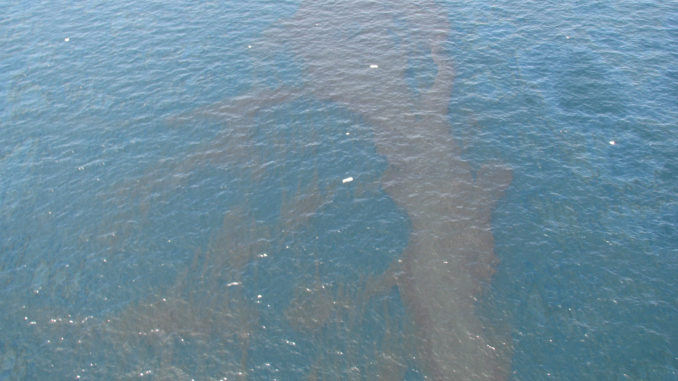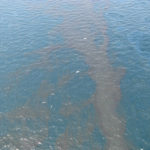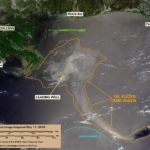
Oil spill in ‘first inning of nine-inning game,’ Overton explains
Concerns about the impact of the Deepwater Horizon oil spill on Louisiana’s marshes as disaster enters its fourth week are understandable but thus far a bit overblown, a retired LSU researcher told LouisianaSportsman.com.
“We’ve had big oil spills in the environment,” said Ed Overton, professor emeritus of the university’s Department of Environmental Sciences. “This has the potential (to be a major disaster), but I don’t think it’s probable.”
Overton, who has studied oil spills since 1977, said there are several factors playing into the formula. One that has worked in favor of a lessened impact is the fact that the oil has largely remained offshore.
“As oil weathers in the environment, it becomes a sticky compound,” he explained. “You go from a toxic problem to a sticky problem with weathered oil.”
Also oil sloshed around by waves and wind actually helps disperse the oil.
“As the weather currents and wind move it around it gets churned up,” Overton said. “Weathering causes evaporation.”
That means the horrible winds a couple of weeks ago, which many worried would push the oil into the marshes, were actually a positive.
“What the heavy winds do is disperses the oil,” Overton said. “I wouldn’t be at all surprised if … some of the oil reached the shore but was dispersed.”
As evaporation occurs and the remaining oil disperses over a wider area, the threat to the marshes is somewhat minimized.
“Oil in large clots and concentrations is much worse than a little bit of oil on the shoreline,” he said.
However, this weathering is a bit of an ironic savior, since it does present some problems.
“(The oil has) had time to form a water-and-oil emulsion,” Overton said. “When it is mixed with water, it forms this stable oil-and-water emulsion we call chocolate mousse.”
The formation of this “mousse” is compounded by the fact that the oil is being released 5,000 feet below the Gulf’s surface.
“The oil is a mile down, and by the time it reaches the surface it’s turned into a mousse,” he said.
And this oily mess creates two layers of oil.
“It’s like putting a hotdog in the water: Some of that hotdog will be above the water, but some of it will be floating right under the water,” he said.
The oil on the surface slowly evaporates and can be treated with dispersants, but that oil floating just beneath the surface can be pushed into the marsh even if the surface sheen remains offshore.
Westward spread of oil not all bad
While the spreading of the oil west of the Mississippi River’s South Pass is causing headaches for anglers as fishing closures are implemented, Overton said it’s actually a good thing because it represents a further dispersal of the oil.
In fact, he said he would like to see the Gulf of Mexico current loop swing far enough north to grab the leaking oil – a development that would push oil through the Florida straits and spit the oil into the Atlantic.
Tar balls have been reported on some Key West, Fla., beaches, but it’s yet to be confirmed that oily sludge originated from the Deepwater Horizon spill.
“People are worried about tar balls appearing on a North Carolina beach, but a tar ball or two is a nuisance – it’s not a problem,” Overton said. “The more dispersed the oil is the better.
“We don’t need this oil on our shore.”
One researcher has developed models showing some of the oil already has reached the loop current, but Overton said the odds of the loop current reaching far enough north to grab a large portion aren’t very good.
If the loop current fails to spread out the oil, Overton said that will result in exponentially greater problems the longer the Deepwater Horizon’s twisted drill stem belches oil.
“The oil is starting to build up,” Overton said. “The more it builds up offshore, the more it can form a black tide.”
If such a “black tide” rolls into the marshes, the situation becomes more serious.
Dispersants not the answer
He said he wasn’t surprised the concrete-and-steel coffer dam failed to work at such extreme depths, and he said the dispersants released at the site of the leak should be stopped.
It’s not that the dispersant is overly toxic.
“The dispersant isn’t so toxic, but the dispersed oil is toxic,” Overton said. “The worry is if you disperse the oil down near the well head, (the oil) won’t reach the surface (where it can weather and evaporate).”
That’s why dispersants are only used well offshore.
“The rule of thumb is you never, ever, ever apply dispersants in near-shore environments,” Overton said. “What causes the toxicity (related to the dispersants) is you’re driving the oil down into the water column.”
The toxicity resulting from surface treatment isn’t a huge problem.
“You get 10 feet down, and there’s no oil there,” he said. “It floats very close to the surface.”
But when oil is treated below water – especially at such extreme depths as this oil leak – the treated oil suspends throughout the water column and becomes a larger problem in terms of fisheries.
“The fish swim through it instead of swimming under it,” Overton said.
Those fish are then subject to contamination and, most likely, death.
Instead of trying to disperse the oil at the well head, he said the only real alternative is to drill alternative wells to divert the oil.
“I think they’re going to have to drill the relief wells, which will take three to six months,” Overton said.
Time not on our side
Overton said this timeframe for drilling relief wells is the big unknown, since the longer the oil flows uncontrolled the higher the odds become of a larger blow-out.
“If it stays this way and we get some luck from the weather and the current, it could be OK,” Overton said. “On the other hand, if (the current constrictions blow out) there could be much more oil released.”
Landfall certain, Mother Nature best defender
Although Overton admitted his expertise doesn’t include effects of oil on vegetation, he said it’s likely there will be a die-off when the oil begins coating marsh grasses.
“Certainly sticky oil will kill the leaf structure,” he said. “It inhibits the oxygen exchange.”
The killing of the visible vegetation is a concern, but the larger issue is potential impacts on root systems – which actually hold together the marsh.
“The green vegetation will grow back but if the oil gets in the roots you can loose a lot of marsh,” Overton said. “You’re talking about the foundation of the whole food chain.”
As much as Overton hopes the oil will remain offshore long enough to disperse and evaporate, the researcher said he’s realistic.
“There will be sections of the coast that will be damaged,” he said, although he admitted it’s impossible to tell how much of the marsh will be impacted. “It will totally depend on how much concentrated oil hits the coast.”
However, he said trying to scour the oil from the marshes would be a huge mistake.
“Normally you can do more damage than good with intrusive cleanup methods,” Overton said. “That’s the take-away message we learned in the (Exxon Valdez) Alaska spill.”
Plus, with an ever-growing amount of oil floating in the Gulf, cleanup would be a losing proposition.
“You can clean it up, and tomorrow it comes right back on you,” Overton said. “But Mother Nature is resilient.”


